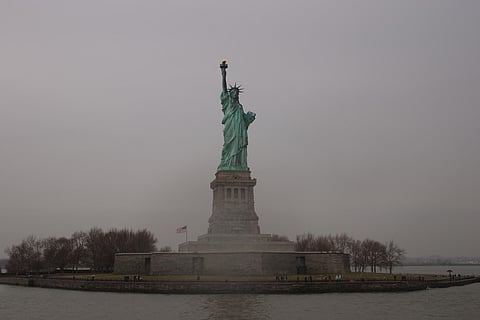Poor America
The idea of the American dream – that vague but iridescent image of the US as a cultural melting pot of opportunity and freedom – has long been an enviable and profitable one. Over the past two centuries, the American boom was largely driven by this image, which drew ambitious and talented people from across the globe, including Southasia. What allowed the US to emerge as the global soft-powerhouse, at the forefront of ideas, markets, education, science, technology and communication, however, is currently at risk of fading away.
The rise of neoconservative politics and an overwhelming dependence on unilateral military might has steadily undermined the American dream and its concomitant multiculturalism, not to mention the country's economy and international goodwill. US foreign policy is quickly losing its ability to create consensus or peace, and is increasingly defined by its capacity to create confrontation, violence and war.
If the US were to lose its global 'brain gain' appeal, it would lead to unexpected economic consequences. Given that the US remains one of the most significant global trading partners – including for India and China – the ramifications of such a downturn would have worldwide and long-term implications. The US Congressional midterm elections taking place in early November may indicate the shape of things to come. This is particularly so at a time when, as the 2008 presidential campaign is already gearing up, the ruling Republican party is experiencing drastically low popularity numbers. This may be due to stalled foreign policy or the incontrovertible domestic economic slowdown.
In an effort to shore up support, George W Bush recently boasted that "the economy is powerful, productive and prosperous". The reality, however, is far from soothing. With an estimated growth of 3.5 percent this year, unemployment at just 4.6 percent and fat profits all around, the economy certainly seems robust. But the US trade deficit, both in absolute size and as a percentage of GDP, is unprecedented. It reached USD 800 billion in 2005 – almost seven percent of GDP – and has accumulated USD 4.5 trillion since 1990. Scrap metal and waste paper are now two of the US's biggest export items. Former Federal Reserve chairman Paul Volcker puts the chances of a major financial crisis in the US within four years at 75 percent.
Running on empty
At the moment, the US remains the largest buyer in the global economy. But it is currently consuming about USD 800 billion more than it is producing, and households spend around USD 500 billion more than they earn. The country also suffers from negative savings and a low rate of investment; indeed, a substantial amount of the savings and investments of the global economy has now shifted to Asia. As a result, the US on a daily basis borrows around USD 3 billion from the rest of the world, largely by selling US treasury bonds. It is this buying and borrowing that is keeping the country's economy apparently robust, but it is a process that is far from sustainable.
There is also a large chunk of US dollars remaining outside the US. While Japan currently has around USD 1 trillion in American currency, China and Saudi Arabia are not far behind. To manage its increasing debt, there is the possibility that the US will be forced to trigger a devaluation of the dollar, along with raising interest rates in the US. Each of these could have a drastic impact on the global economy.
None of this means that Americans themselves have been insulated from the growing problems. The war in Iraq and the larger 'war on terror' have sapped funding for social-sector expenditure, including for education and health care. When Hurricane Katrina ripped through New Orleans in August 2005, the myth of the American dream was exposed for all to see. The rising tide of economic growth had obviously failed to lift the boats of the poor. An estimated 37 million of the country's 300 million people are poor in the US, many of them people of colour; at 12.7 percent, that poverty rate is the highest in the developed world.
Inequality, too, is on the rise. The US's Gini index, a measure of income inequality, is the highest in the developed world. An American chief executive now earns 300 times the average wage, tenfold more than in 1970. Other indicators of economic vulnerability include the proportion of people working, and the stagnation of middle-class income levels. Additional oil price hikes could easily exacerbate the economy's condition.
The current state of affairs has not been lost on the American psyche. A recent survey found that more than 60 percent of US citizens are sceptical of free trade. Another survey found that nine out of ten worry about their jobs going overseas. The American dream has indeed arrived at the crossroads.

